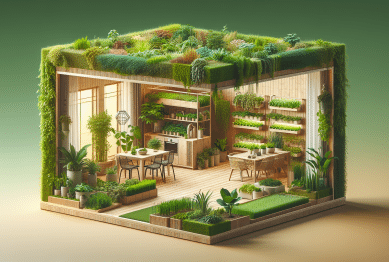Explore the hidden ways smart thermostats can transform your home’s energy efficiency while helping lower utility bills and making garden lifestyles more sustainable. This guide sheds light on their features, how they fit into modern home automation, and what owners need to know about installation, savings, and eco-friendly outcomes.
Understanding Smart Thermostats and Home Energy Use
Smart thermostats are quickly becoming a household staple. These small but powerful devices make it easier for homeowners to control heating and cooling from anywhere using their smartphones or voice assistants. Unlike traditional models, a smart thermostat can learn household routines and adjust temperatures automatically. That means less energy waste and more comfort. People often find it surprising how much energy heating and cooling systems consume. In an average home, nearly half the energy bill can be linked to temperature control. So, upgrading to more intelligent tech is a logical step for eco-conscious families (Source: https://www.energy.gov/energysaver/thermostats).
Home automation is evolving rapidly. Adding smart thermostats to the mix can unify control of climate, lighting, and even garden appliances. Many new homeowners discover that managing environmental controls from a single dashboard streamlines life and adds peace of mind. Whether you’re watering plants with a smart irrigation system or changing the temperature as you head home, it’s hard to imagine going back. More residents are also choosing devices that work with solar panels and other renewable energy solutions, supporting broader eco-friendly goals.
Growing interest in sustainable home technology is driven by both comfort and financial reasons. Research by major engineering groups has shown that occupants typically waste energy by forgetting to adjust thermostats when leaving or sleeping. Smart features take human error out of the equation. Some smart thermostat models display real-time usage data, offering insight into what’s using the most energy. This transparency lets you make smarter decisions and track the difference your efforts make for your household and garden systems (Source: https://www.energy.gov/energysaver/smart-home-energy-management).
Key Features That Improve Home Energy Efficiency
The most impactful feature of a smart thermostat is learning capability. These devices analyze personal schedules, recognize when you’re home or away, and make climate adjustments in real time. Motion sensors and geofencing functions let your home ‘know’ when to use less power. Some units even use weather forecasts to prepare rooms ahead of extreme temperatures, reducing strain on HVAC systems. Tools like adaptive recovery start heating or cooling before you return, so comfort is balanced with savings.
Data integration is helpful for owners who want a detailed look at energy consumption. By tracking patterns hour-by-hour, users can easily spot trends and areas to improve. Many smart thermostats offer monthly reports, comparing current energy spend with prior periods and local homes of similar size. Some devices sync with energy provider discounts, making savings opportunities more transparent without additional research. In homes with indoor gardens or exotic plants, tailored scheduling can keep sensitive vegetation thriving without human oversight.
Compatibility is key when considering future upgrades. Look for smart thermostats that connect seamlessly with larger home automation systems and security networks. The ability to coordinate heating and lighting can simulate occupancy when away, adding a layer of security. Homeowners often choose models with voice assistant integration, remote access via apps, and compatibility with smart vents for room-by-room climate control. These features collectively reduce wasted resources and support a more harmonious garden environment both indoors and out (Source: https://www.energystar.gov/products/heating_cooling/smart_thermostats).
Real Data on Energy Savings and Environmental Impact
Energy savings from smart thermostats go beyond anecdotal evidence. Studies conducted by major energy research institutions have reported that these devices can lower annual heating and cooling costs by about 10-12%. In some cases, savings may be even higher for households with irregular schedules or in regions with extreme temperature swings. The reduction in energy use automatically carries through to lower household emissions, making the switch a practical way to support climate action goals (Source: https://www.nrel.gov/docs/fy19osti/72172.pdf).
The environmental impact isn’t only about numbers on the bill. Smart thermostats help lower demand on power grids at peak times, minimizing the overall carbon footprint attributed to residential neighborhoods. Some utility providers offer rebates for installing energy-saving devices, as their widespread adoption lightens infrastructure strain. Urban planners and green advocates recognize these systems as an accessible step for homeowners to promote sustainability, joining community-wide efforts to conserve resources.
Actual user experiences support the formal data. Homeowners frequently report feeling more control over indoor comfort without the guilt associated with excessive energy use. Gardens benefit as well, especially those maintained in sunrooms or with climate-sensitive species, where stable temperatures and automated care schedules protect investments in horticulture. The connection between sustainable homes and personal satisfaction is echoed by recurring feedback in home and garden forums, reinforcing the value found in smarter management (Source: https://www.epa.gov/greenhomes/what-you-can-do-energy).
Installation and Setup: What Homeowners Should Know
Smart thermostats are designed with homeowners in mind, and installation is usually straightforward. Most models come with step-by-step instructions and online videos, making DIY setup approachable. Still, there are a few things to check first. Compatibility with current HVAC systems is important; not every older furnace or air conditioner supports advanced controls. Checking for a ‘C-wire’ in your setup often determines if installation is plug-and-play or if extra wiring is needed. If unsure, consulting a professional can ensure safety and proper operation (Source: https://www.energy.gov/energysaver/installing-and-setting-your-programmable-thermostat).
Once installed, configuring schedules is next. Users can typically input routines for weekdays, weekends, and holidays, as well as choose from preset energy-saving programs. Integration with smartphone apps puts climate control at a fingertip. Some platforms require creating an account; others link directly through Wi-Fi or Bluetooth. Careful calibration ensures that households and gardens receive the right degree of warmth or cooling, keeping pets and sensitive plants healthy while reducing utility costs.
Beyond initial setup, periodic maintenance is minimal. It’s smart to check for software updates and adjust custom schedules as household patterns change. Many devices send alerts when filters need changing or if an HVAC issue is detected. In households with indoor garden spaces, settings can be further optimized as seasons and plant requirements shift, merging technology with natural cycles. Home automation forums and energy provider hotlines often provide free advice for optimizing device use and troubleshooting common concerns.
The Bigger Picture: Smart Homes, Gardens, and the Future
Wider adoption of smart home devices like thermostats signals a shift toward sustainable urban and suburban living. Neighborhoods embracing home automation as part of their culture often see ripple effects—lower shared energy consumption, more resilient power grids, and greener local environments. Many garden club members and sustainability advocates highlight this technology’s role in climate action plans, especially where outdoor and indoor cultivation intersect with advanced irrigation, lighting, and air quality monitoring (Source: https://www.nature.org/en-us/what-we-do/our-insights/perspectives/urban-greening-technology/).
Looking forward, integration possibilities are expanding. Smart thermostats can blend with solar board monitoring, battery storage, and smart meters for better synergy with renewable resources. Climate-conscious landscaping and gardening practices now often include home automation at the core. Data-driven software updates mean that personal comfort, garden health, and sustainability measures only get smarter with time. Homeowners joining this movement not only benefit personally but are helping build cleaner communities for the next generation.
For those new to this technology, the entry point is more affordable and accessible than ever before. Government programs, utility rebates, and nonprofit guides support wider adoption. Research organizations constantly evaluate the best practices and innovations, offering transparent reviews and educational materials for hesitant buyers. By exploring the impact and potential of smart thermostats now, families join a broader effort that values technology, nature, and practical living equally—setting the stage for a more resource-efficient, eco-friendly home and garden experience.
References
1. U.S. Department of Energy. (2023). Thermostats. Retrieved from https://www.energy.gov/energysaver/thermostats
2. U.S. Department of Energy. (2022). Smart Home Energy Management Systems. Retrieved from https://www.energy.gov/energysaver/smart-home-energy-management
3. ENERGY STAR. (2023). Smart Thermostats. Retrieved from https://www.energystar.gov/products/heating_cooling/smart_thermostats
4. National Renewable Energy Laboratory. (2019). Energy Savings from Smart Thermostats. Retrieved from https://www.nrel.gov/docs/fy19osti/72172.pdf
5. U.S. Environmental Protection Agency. (2021). What You Can Do: Energy. Retrieved from https://www.epa.gov/greenhomes/what-you-can-do-energy
6. The Nature Conservancy. (2023). Urban Greening and Technology. Retrieved from https://www.nature.org/en-us/what-we-do/our-insights/perspectives/urban-greening-technology/









